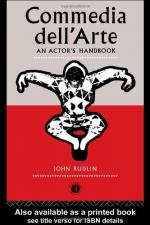|
This section contains 4,130 words (approx. 14 pages at 300 words per page) |

|
SOURCE: Forti-Lewis, Angelica. “Commedia dell'Arte.” In Fools and Jesters in Literature, Art, and History: A Bio-Bibliographical Sourcebook, edited by Vicki K. Janik, pp. 146-54. Westport, CT: Greenwood Press, 1998.
In the following essay, Forti-Lewis provides an overview of the commedia dell'arte in the context of a larger study of fools and jesters in world literature.
Background
The commedia dell'arte was a unique development in the history of the theater in Western Europe. It flourished in Italy in the second half of the sixteenth century and throughout the seventeenth century. By the middle of the eighteenth century it was a less important factor in the theater, although its influence cannot be said to have died out.
Before commedia dell'arte became a firmly established genre, it had its history of development, like any other literary movement. It inherited a fragmentary legacy from many sources: from the commedia erudita (written comedy) of...
|
This section contains 4,130 words (approx. 14 pages at 300 words per page) |

|


